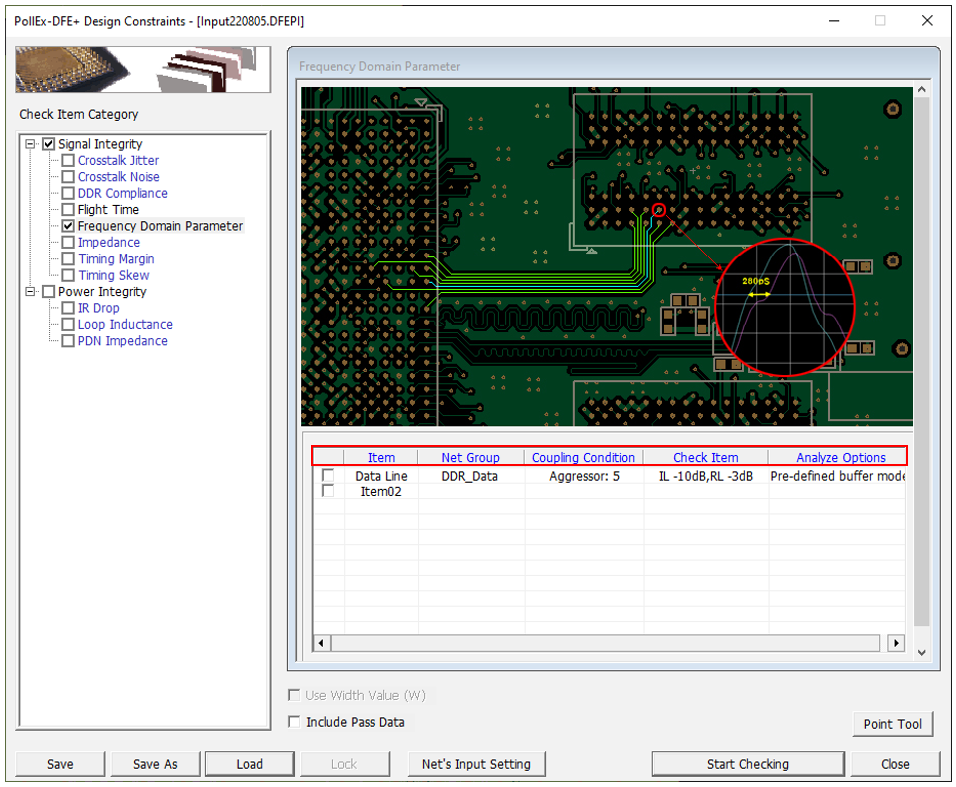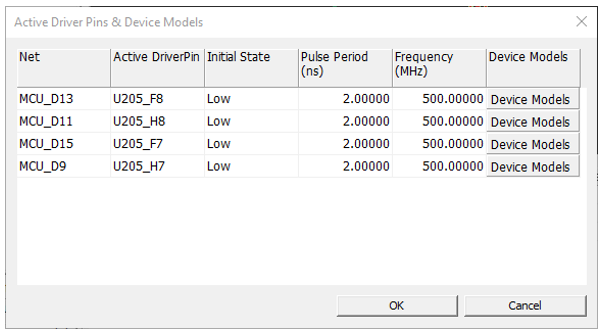Frequency Domain Parameter
This item analyzes 4 types of frequency domain parameter (S11, S21, S13, S14) using the standard s-parameter port numbering scheme and a signal is injected at port1.
- Return Loss (S11): The single-ended return loss is recommended to be less than 15dB up to 3 times the Nyquist frequency
- Insertion Loss (S21): The single-ended insertion loss is recommended to stay within 0 to 10dB up to 3 times the Nyquist frequency of operation. For example, if the target frequency is 8Gbps (4GHz Nyquist), the single-ended insertion loss should stay under 10dB up to 12GHz
- Near-end Crosstalk(S31) and Far-end Crosstalk(S41) are recommended to be under 25dB for frequencies up to 3times the Nyquist.

Figure 1.
- Item: Sub item name. User can enter arbitrary.
- Net Group: Select target net groups to be tested. Allow multiple net groups.
- Coupling Condition:
- Max number of adjacent signal layers to couple
- Max number of adjacent traces to couple
- Min parallel length for coupling (mm)
- Max via coupling distance (mm)
- Max trace coupling distance (mm)
- Check Item:
- Insertion Loss Limit(dB): If Insertion Loss value is smaller than the limit value user entered, it fails.
- Return Path(dB): If Return Path value is bigger than the limit value user entered, it fails.
- Near-end Crosstalk Limit(dB): If NEXT value is smaller than the limit value user entered, it fails.
- Far-end Crosstalk Limit(dB): If FEXT value is smaller than the limit value user entered, it fails.
- Analyze Option Dialog:
- Use pre-defined buffer model: The buffer model set in the electrical pin part of UPE is used as default. The user cannot change the buffer model here.
- Use user defined buffer model: You can assign simulation buffer model.
- Active Driver Pins & Device Models: It allows you to select
active driver pins of the coupled nets. To make a net quiet, NONE
must be selected for the active driver pin selection. You can define
the input signal and make changes on the device model selection for
driver and receiver pins of each coupled net by clicking Input
Signal and Device Models, respectively.

Figure 2. - Default Device Models: When the device models are not available in the part data, the default device models defined here are used for transient simulation of signal integrity analyses. With the use of Linear Device Modeler, you can create linear output (driver) and input (receiver) device models and store them in a linear device model file. PollEx DFE+ provides a system default linear device model file, UDVS.dmf.
- Network Analysis Parameters
- Simulation time: End time of the SPICE transient analysis.
- Signaling time: Input Signal having pulse period (2ns) will be excited to the net until the time assigned here.
- Preamble time: Initial period befor data transmission begins. It allows the system to stabilize before the actual data transfer starts.